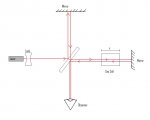LPF Donation via Stripe | LPF Donation - Other Methods
Links below open in new window
ArcticMyst Security by Avery

You are using an out of date browser. It may not display this or other websites correctly.
You should upgrade or use an alternative browser.
You should upgrade or use an alternative browser.
interferometry
- Thread starter disma
- Start date



i work with interferometers quite a bit with lasers. I have built several Michelsons, a Fabry-Perot, I've used a shear plate interf. and know how to set up a Lloyd's mirror and Mach-Zenders. An intereferometer is an instrument that uses intereference from light that has been split into two seperate paths and rejoined later on to study something. That something can be a lot of things. Currently I'm using Michelsons to determine the coherence length and visibility of the blu-rays to see if they are usable to write the holograms the company I work for uses. I'm headed out the door, but if you want to know anything else let me know and I'll do my best to answer any questions.
wow, yeah I just read that first sentence. It's pretty much terrible haha. Beams do not split like that. An interferometer is what splits the beams apart. When the beams are split up they take different paths. If the paths lengths are different the light may no longer be in phase. This can cause interference. If the path length differenceis an integer multiples of the wavelength then the two beams will interfere constructively and the intensity will be high. If the path length difference is a half integer multiple then there will be destructive interference and the intensity will be low. For path length differences in between these values the intensity will be somewhere in between. We can use this fact to study various things. I use it to determine coherence length which is related to the spread in wavelength the laser emits. My professor uses interferometers to study the wave nature of atoms in order to discover tings about the atoms. There are a lot of uses for interferometers, most of which I am clueless about. Here is a picture of a Michelson interferometer just as an example. This particular set up has a gas cell in the path of one beam so that the index of refraction can be determined for that gas.
EDIT: by the way, that observer picture is not actually meant to be an eye. that would not be a good idea. its usually a screen or detector of some sort.
EDIT: by the way, that observer picture is not actually meant to be an eye. that would not be a good idea. its usually a screen or detector of some sort.
Attachments
For that particular experiment you change the pressure within the cell and count how many fringes go by. There is a formula that can be derived from a few other principles that basically relates the change in pressure and the change in the fringes that go by to the index of refraction. The fringes are the light and dark regions in the interference pattern.
Switch
0
- Joined
- Dec 9, 2007
- Messages
- 3,327
- Points
- 0
The brewster window I used as a dichro for combining works pretty well for green lasers at 45 degrees. :-/
climbak said:microscope slides work great. i use them almost exclusively.
WHAT?
you use microscope slides as dichros?? or to split the beams?
- Joined
- Aug 25, 2007
- Messages
- 2,007
- Points
- 63
Also, interferometry can be used to measure the thickness of thin films, without even doing anything else with the light. Doesn't even have to be coherent. Light hits the surface at a non-perpendicular angle: some is reflected at the air-film interface, and some goes through. Then, some light is reflected at the film-substrate interface. Light from both paths then hits the detector, but since the paths were different lengths, the light from the different paths will be out of phase, causing interference. With some more complication and a little math, you can calculate the difference in path lengths, and therefore the film thickness.
This is also exactly what you do with x-ray diffraction, kind of. Except it's x-rays, and the x-rays reflect off of different planes of atoms in the material, giving you the interatomic (or "d") spacing in a material. Bragg's law is basically derived straight from the picture I described above.
This is also exactly what you do with x-ray diffraction, kind of. Except it's x-rays, and the x-rays reflect off of different planes of atoms in the material, giving you the interatomic (or "d") spacing in a material. Bragg's law is basically derived straight from the picture I described above.
pullbangdead said:Also, interferometry can be used to measure the thickness of thin films, without even doing anything else with the light. Doesn't even have to be coherent. Light hits the surface at a non-perpendicular angle: some is reflected at the air-film interface, and some goes through. Then, some light is reflected at the film-substrate interface. Light from both paths then hits the detector, but since the paths were different lengths, the light from the different paths will be out of phase, causing interference. With some more complication and a little math, you can calculate the difference in path lengths, and therefore the film thickness.
This is also exactly what you do with x-ray diffraction, kind of. Except it's x-rays, and the x-rays reflect off of different planes of atoms in the material, giving you the interatomic (or "d") spacing in a material. Bragg's law is basically derived straight from the picture I described above.
So they use x-rays to determine the difference/distance from something to something else?



